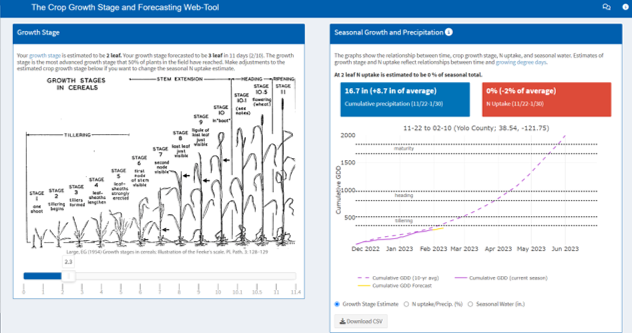The growth stage of a crop is a critical piece of information for growers and agronomists. For small grain crops like wheat and triticale, many field management decisions are sensitive to the stage of crop development. These include irrigation, fertilizer additions, herbicide and pesticide applications, and harvest timing. In addition, the planting date, the amount and timing of rainfall and/or irrigation, and cumulative seasonal temperatures all impact how rapidly a crop emerges, develops and matures. Because of the extreme variability in winter weather in the state, rates of development for small grain crops in California are not always consistent from year-to-year and farm-to-farm. This can make precision management and planning more difficult.
As a result, we have created a new interactive website, The Crop Growth Stage and Forecasting Web-Tool, to improve the understanding of crop growth stages for fall-planted small grain crops in California. Users of this tool can input site- and time-specific information (e.g. location, planting date, crop type, irrigation) and receive a growth stage estimate for their wheat and triticale crops.
The growth stage estimate is based on a model developed from multi-season observations of wheat and triticale development in University of California field trials. The web-tool utilizes site- and time-specific weather to produce a predicted growth stage, alongside interactive graphs related to seasonal water and nitrogen (N) uptake patterns. The graphs include historical data (10-yr average), making it easy to compare the current season to average conditions. Forecasts are also available for the main crop-growing regions of California enabling users to anticipate changes in crop growth and development in the near-term. Users can also download their location-specific data for further exploration.
The Crop Growth Stage and Forecasting Web-Tool is one of a growing number of interactive, decision support web-tools available on the UC Small Grains Research and Information Center Website. These tools feature interactive user experience and communicate spatiotemporally specific information on a growing number of topics related to the management of small grains in California. Check them out at https://smallgrains.ucanr.edu/Decision_Support_Tools/. Also, sign up for updates related to UC small grain crop research and extension at the UC Small Grains Blog.

